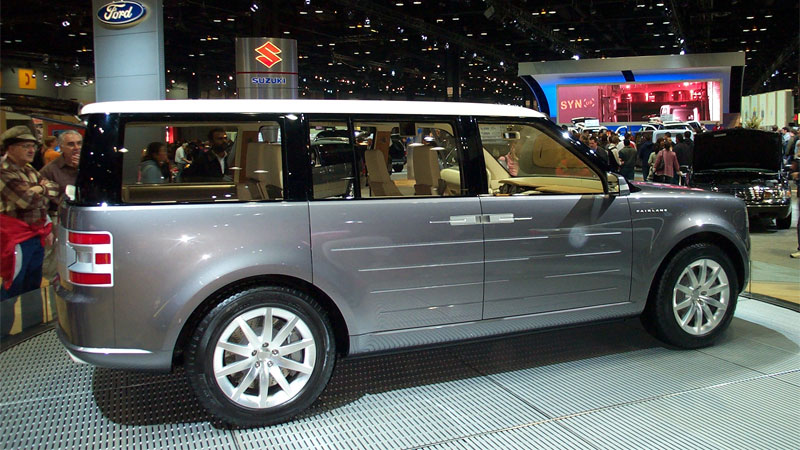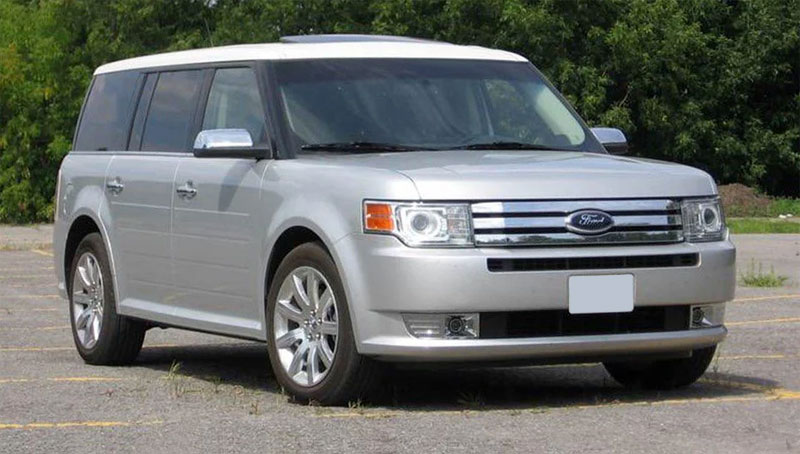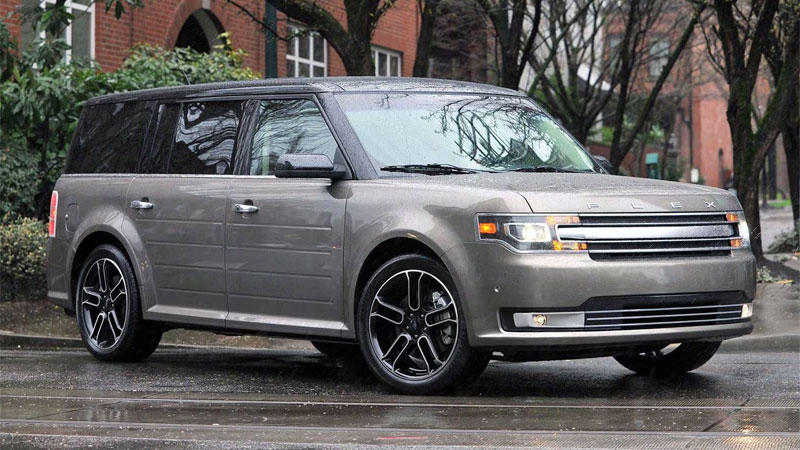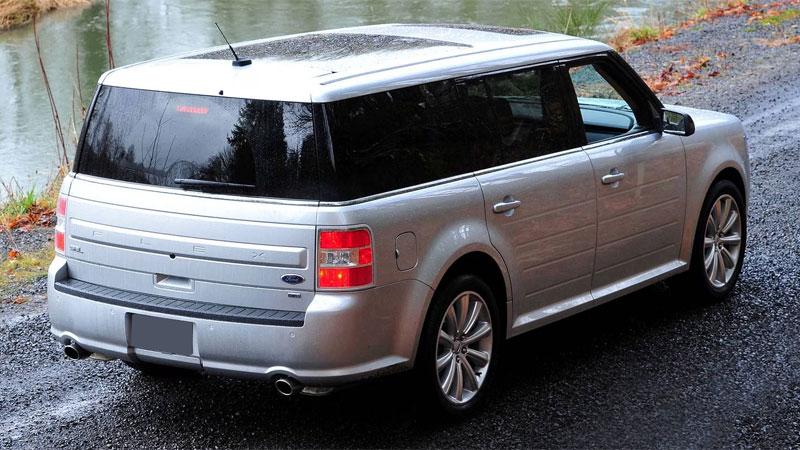When the Ford Flex first rolled off assembly lines in 2008, it turned heads with its bold, boxy exterior that harkened back to the station wagons of yesteryear. Yet this was no wood-paneled family truckster—the Flex brought style, technology, and efficiency to the crossover segment.
During its decade-long lifespan, the Flex attracted a devoted following before eventually fading into obscurity. But it left behind an enduring legacy as a uniquely styled pioneer bridging the gap between station wagons and modern crossovers.
Even today, its funky looks and spacious but nimble footprint is sought after by used car buyers wanting to stand out from the crowd. The Flex’s story is one of a daring concept that was perhaps ahead of its time, but no less innovative. Let’s take a nostalgic ride through the life of Ford’s box-on-wheels.
- Known for: Bold, retro-styled box shape that uniquely bridged station wagons and modern crossovers.
- First Model Year: 2009
- Final Model Year: 2019
- Original Price in 2009: $28,995 (around $42k USD today)
- Total Sold in the US: 309,209 [source]
See Also – History of the Pontiac Aztek
What Does ‘Flex’ Stand For?
Though some say that FLEX is an acronym for “Ford Luxury Extended X(crossover)” or “Ford Limited Edition X-Over”, it’s not the case. Nor does it have anything to do with flex fuel.
The Ford Flex was named to encapsulate the essence of “Flexibility,” highlighting the crossover’s adaptable nature and its capability to meet various transportation needs. This choice in naming was advocated by Elena Ford and marked a shift from the vehicle’s original concept name, ‘Fairlane,’ which was introduced in 2005.
The transition to “Flex” was intended to better communicate the model’s key attribute of versatility, distinguishing it as a vehicle that could flexibly conform to the diverse demands of its users.
The Fairlane Concept

The concept car version of the Ford Flex was originally introduced as the Ford Fairlane at the 2005 North American International Auto Show.
The Fairlane concept was a modern interpretation of the classic Ford station wagon, designed to offer a fresh take on family transportation. It featured three rows of seating, a low-slung body, and a design that emphasized horizontal lines, which gave it a unique, boxy, and bold appearance.
The concept vehicle’s design elements, such as its distinctive side grooves and flat roof, carried over into the production version of the Ford Flex, which debuted in 2008 for the 2009 model year.
The Ford Flex production model maintained the spirit of the Fairlane concept, offering a versatile interior, advanced features, and a design that stood out from the typical SUVs and minivans of its time.
Read Also – Dodge Nitro History
Ford Flex Generations
Only one generation of the Flex, which spanned from 2009 to 2019, was produced but it featured a mid-cycle refresh for the 2013 model year.
1st Generation – D4 (2009-2012)
The Ford Flex made its debut with a design that was a departure from the typical crossover SUVs of the time. Its straight lines and boxy form were complemented by a range of unique features that set it apart.
Its retro-modern design included a standard chrome grille reminiscent of vintage Americana and a distinctive multi-panel Vista Roof that offered skylights for the second and third rows.

The Flex boasted a spacious interior with three rows of seating. The second row could be configured with either a bench seat to accommodate three passengers or with two individual bucket seats. The third row had enough space for adults and could be easily folded flat to increase cargo space.
Early models were equipped with Ford’s SYNC system, which allowed voice control of phones and music devices. Over the years, this system was updated to SYNC 3, which included a touchscreen and enhanced connectivity features.
The base 3.5-liter V6 engine provided adequate power, while the optional EcoBoost V6 introduced in 2010 offered a more spirited driving experience with 355 horsepower and standard all-wheel drive.
1st Generation (Facelift) – D4 (2013-2019)
The 2013 refresh brought several updates that aimed to keep the Flex competitive in a changing market.
The most noticeable change was the front fascia, where the traditional Ford blue oval was removed in favor of prominent FLEX lettering on the hood’s leading edge. The headlight clusters, grille, and fog light assemblies were all redesigned to give a more modern appearance.

Ford improved the quality of materials inside the Flex, offering new color combinations, updated seat trims, and additional soft-touch surfaces. The MyFord Touch system was introduced to provide a more advanced and user-friendly interface for controlling vehicle functions.
The updated Flex offered an array of advanced safety features, including radar-based adaptive cruise control, a blind-spot information system, and Ford’s Active Park Assist, which could steer the vehicle into a parking spot with minimal driver input.
The standard 3.5-liter V6 engine continued to serve as the base powerplant, delivering a reliable performance for daily driving. The top-tier EcoBoost V6 remained an attractive option for those seeking more power, now producing 365 horsepower and offering a more engaging driving experience with its all-wheel-drive system.
This twin-turbocharged engine allowed the Flex to deliver acceleration figures that were competitive with much smaller and sportier vehicles.
Despite its size, the Flex was praised for its car-like handling characteristics. It provided a comfortable ride quality while also maintaining composure around corners, a balance achieved by its independent rear suspension and a lower center of gravity compared to traditional SUVs.
The Flex’s interior remained one of its strongest selling points. With both the second and third rows able to fold flat, it offered a cavernous cargo area. Additionally, the Flex could be equipped with a refrigerated console, making it ideal for family road trips or tailgating.
Ford offered the Flex in several trim levels, including the SE, SEL, and the top-of-the-line Limited. Options and packages varied, providing buyers with choices ranging from premium Sony sound systems to leather seating and advanced navigation systems.
See Also – Chevy SSR (the Retro-Styled Convertible Pickup)
Why Was the Ford Flex Discontinued?
The discontinuation of the Ford Flex was influenced by a combination of factors, including changing consumer tastes and market trends.
The automotive industry has witnessed a shift in preference towards SUVs and crossovers that offer higher ride heights and a more rugged aesthetic, which did not align with the Flex’s boxy, station wagon-like design.
Additionally, sales of the Flex had been on a decline, leading Ford to evaluate its lineup and discontinue models with weaker sales performance to optimize cost-efficiency and resource allocation. The market’s focus has increasingly moved towards more profitable and in-demand vehicles, such as trucks and larger SUVs, influencing Ford’s decision to streamline their product offerings.
Furthermore, the Flex had been on the market for over a decade with only one significant update, and with vehicle designs typically having a lifecycle, Ford may have deemed it more advantageous to invest in newer models rather than undertake a comprehensive redesign of the Flex.
Despite the vehicle’s appeal to a niche market that appreciated its spacious interior, distinctive style, and pleasant driving dynamics, these factors were insufficient to justify its continuation in an evolving and competitive automotive landscape.
See Also – Why Was the Toyota Land Cruiser Discontinued?
Common Problems With the Ford Flex
The Ford Flex, while generally well-regarded, has had its share of common problems reported by owners and automotive experts. Some of these issues include:
- Water Pump Failures. The water pump in some Ford Flex models, particularly those with the 3.5-liter V6 engine, can fail prematurely. This is a major issue as the water pump is internal and can leak coolant into the engine, potentially causing severe engine damage if not addressed promptly.
- Power Transfer Unit (PTU) Leaks. The PTU, part of the all-wheel-drive system, has been known to develop leaks. This can lead to the PTU overheating and failing if the fluid level drops too low and is not attended to quickly.
- Door Ajar Light Issues. Some Flex owners have experienced problems with the door ajar light staying on even when all doors are properly closed. This can be due to a faulty door latch sensor and can prevent the doors from locking and the interior lights from turning off.
- Swollen Lug Nuts. The lug nuts on the Ford Flex can become swollen over time due to a two-piece design that can allow moisture to get trapped and cause the outer cap to swell. This makes it difficult to remove the lug nuts with standard tools and can be problematic during tire changes.
- MyFord Touch Infotainment Problems. Owners have reported issues with the MyFord Touch system, including unresponsiveness, crashing, and problems with connectivity and navigation.
- Brake Wear and Noise. Some Flex models may experience premature brake wear or noise from the brakes, which could be due to the size and weight of the vehicle putting extra stress on the braking system.
- Electrical Issues. There have been reports of various electrical issues, such as malfunctioning interior lights, battery drain, and problems with the electronic power-assisted steering system.
Best Year of Ford Flex
The best years for the Ford Flex, according to reliability and owner satisfaction, are generally considered to be the 2016, 2017, 2018, and 2019 models.
These years are recommended due to having the fewest reported issues and incorporating several key updates that improved the vehicle’s technology and overall performance. The introduction of the SYNC 3 infotainment system in 2016, which was more user-friendly than the previous MyFord Touch system, is one of the significant improvements that make these later models more desirable.
Additionally, these model years benefit from the refresh that occurred in 2013, which addressed some earlier issues and updated the vehicle’s styling and features.
- History of the Chevrolet SSR: The Retro-Styled Convertible Pickup - Apr 25, 2024
- The History of the BMW M Coupe (the “Clown Shoe”) - Mar 26, 2024
- The History of the Ford Flex - Feb 28, 2024



